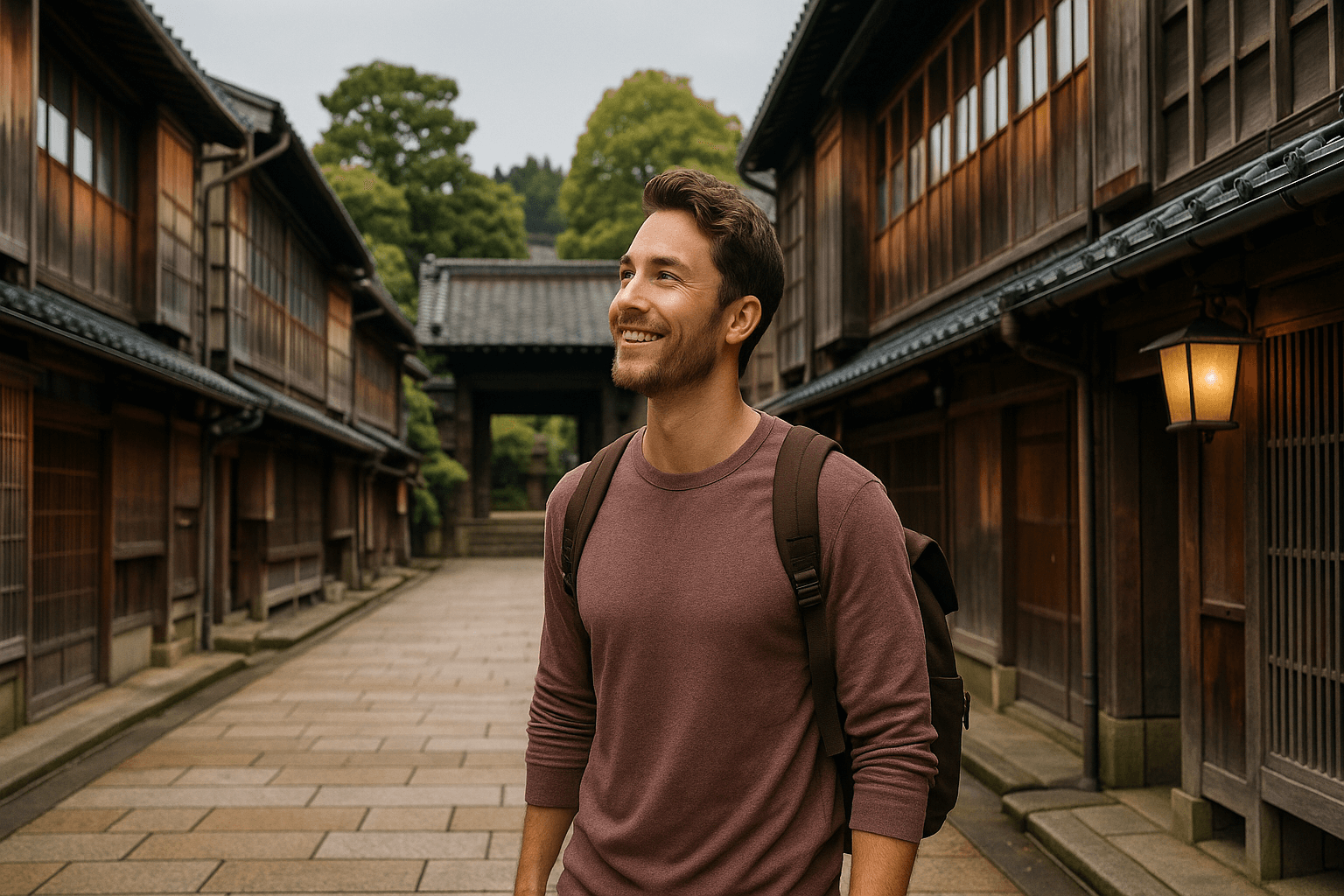Tucked away on Japan’s scenic Hokuriku coast, Kanazawa is often described as the “mini-Kyoto”—a city that blends samurai heritage, geisha traditions, elegant gardens, and cutting-edge art. Yet Kanazawa is much more than just a smaller version of its famous Kansai cousin. It is a destination with a unique identity, rich history, and contemporary flair that make it a must-visit for travelers who want to go beyond Tokyo, Kyoto, and Osaka.
This Kanazawa travel guide will walk you through the highlights of the city: stunning gardens, preserved samurai and geisha districts, world-class museums, and unforgettable local cuisine. By the end, you’ll see why Kanazawa deserves a top spot on your Japan itinerary.
Why Kanazawa is Called the Mini-Kyoto
Kanazawa flourished during the Edo period as the seat of the powerful Maeda clan, who invested heavily in arts, crafts, and culture. Like Kyoto, Kanazawa escaped major damage during World War II, meaning many of its historical neighborhoods remain intact. Visitors will find:
- Traditional districts with preserved wooden townhouses.
- Kenrokuen Garden, one of Japan’s “Three Great Gardens.”
- Geisha teahouses and samurai residences, offering glimpses of centuries-old traditions.
- Cultural crafts, such as gold leaf, Kutani porcelain, and Kaga Yuzen silk dyeing.
But unlike Kyoto, Kanazawa is less crowded, more compact, and easier to explore at a slower pace. It’s the perfect place for travelers seeking authentic Japanese culture without the intensity of bigger tourist hubs.
Kenrokuen Garden and Kanazawa Castle
Kenrokuen Garden
No Kanazawa travel guide is complete without Kenrokuen, one of Japan’s most celebrated gardens.
- Meaning of “Kenrokuen”: The name translates to “Garden of Six Attributes,” symbolizing spaciousness, seclusion, artifice, antiquity, watercourses, and panoramas.
- Seasonal beauty:
- Spring: Cherry blossoms transform the landscape into a pink wonderland.
- Summer: Vibrant irises and lush greenery.
- Autumn: Fiery red and golden leaves.
- Winter: Snow-covered pines supported by ropes in a technique called yukitsuri.
- Highlights: Kasumigaike Pond, Kotojitoro Lantern (a Kanazawa symbol), and tea houses offering matcha with seasonal sweets.
Admission is just ¥320, making it one of the best-value cultural experiences in Japan.
Kanazawa Castle
Adjacent to Kenrokuen stands Kanazawa Castle, the seat of the Maeda clan for centuries.
- Architecture: The reconstructed Ishikawa Gate, Hishi Yagura (turret), and Gojikken Nagaya (storehouse) showcase the castle’s grand scale.
- Grounds: Wide lawns and gardens invite leisurely strolls.
- Free areas: Large parts of the castle grounds are free to enter, making it a great budget-friendly stop.
Together, Kenrokuen and Kanazawa Castle form the cultural heart of the city, offering a blend of nature, history, and beauty.
Samurai and Geisha Districts
Kanazawa’s charm lies in its preserved historical neighborhoods, where you can step back into the Edo period.
Nagamachi Samurai District
Located near Kanazawa Castle, Nagamachi was once home to samurai and their families. Today, narrow lanes, clay walls, and restored residences evoke the city’s warrior past.
- Nomura Samurai House: A beautifully preserved home with tatami rooms, samurai armor displays, and a small but exquisite garden.
- Winding alleys: Perfect for wandering and imagining life during feudal times.
- Shops and cafés: Hidden gems offering local crafts and refreshments.
Higashi Chaya Geisha District
One of Kanazawa’s most atmospheric spots, Higashi Chaya is a geisha entertainment district with traditional wooden teahouses (chaya).
- Shima Teahouse: A preserved geisha house where you can see instruments, tatami rooms, and artifacts from centuries past.
- Kaikaro Teahouse: Still active today, it occasionally hosts geisha performances.
- Atmosphere: The district glows beautifully in the evening, when lanterns illuminate the wooden facades.
Other geisha districts worth exploring include Nishi Chaya and Kazuemachi, smaller but equally charming.
21st Century Museum of Contemporary Art
Kanazawa isn’t just about history—it’s also a hub of modern creativity. The 21st Century Museum of Contemporary Art is a bold contrast to the city’s traditional areas and has become an architectural and cultural icon.
- Design: Created by architects SANAA, the building is a circular glass structure symbolizing openness and accessibility.
- Exhibits: Rotating exhibitions of international and Japanese contemporary artists.
- Permanent highlights:
- The Swimming Pool by Leandro Erlich, where visitors appear submerged under water.
- Interactive installations that encourage participation.
Even if contemporary art isn’t usually your interest, the museum is inspiring, thought-provoking, and a must for anyone curious about modern Japan’s creative side.
Local Food Specialties
Kanazawa is a food lover’s paradise, thanks to its coastal location and Maeda clan’s historical patronage of fine cuisine. Any Kanazawa travel guide should highlight the city’s culinary treasures.
Seafood
- Kanazawa Port brings in fresh catches daily.
- Omicho Market: Known as “Kanazawa’s kitchen,” it’s the best place to sample seafood bowls (kaisendon), grilled fish, and oysters.
- Snow crab (zuwai gani): A winter delicacy highly prized in Kanazawa.
Sushi
Kanazawa is famous for nodoguro (blackthroat seaperch) and amaebi (sweet shrimp) sushi. Try local sushi restaurants for seasonal fish not found in Tokyo.
Gold Leaf
Kanazawa produces over 90% of Japan’s gold leaf, used in crafts and cuisine. You’ll find:
- Gold leaf ice cream.
- Gold-dusted sake.
- Shops offering hands-on workshops.
Kaga Cuisine
A refined local cuisine developed under samurai patronage:
- Jibuni: A duck stew thickened with flour.
- Kaga vegetables: Unique varieties cultivated only in Ishikawa Prefecture.
Sweets and Tea
Kanazawa is also known for its wagashi (traditional sweets), especially when paired with matcha at teahouses in Higashi Chaya.
Conclusion
Kanazawa may be called the mini-Kyoto, but it has an identity all its own. With the elegance of Kenrokuen Garden, the history of samurai and geisha districts, the creativity of the 21st Century Museum, and the richness of its local cuisine, Kanazawa offers an experience that feels both timeless and refreshingly modern.
This Kanazawa travel guide shows why the city is one of Japan’s cultural gems. It’s compact enough to explore in two or three days, yet rich enough to reward deeper stays. Most importantly, it offers a glimpse into a Japan where tradition and innovation coexist beautifully—without the overwhelming crowds of Kyoto.
If you’re planning a trip to Japan, make time for Kanazawa. Wander its gardens, savor its seafood, stroll its preserved districts, and be inspired by its art. You’ll leave with memories of a city that may be “mini” in name, but is monumental in charm.

